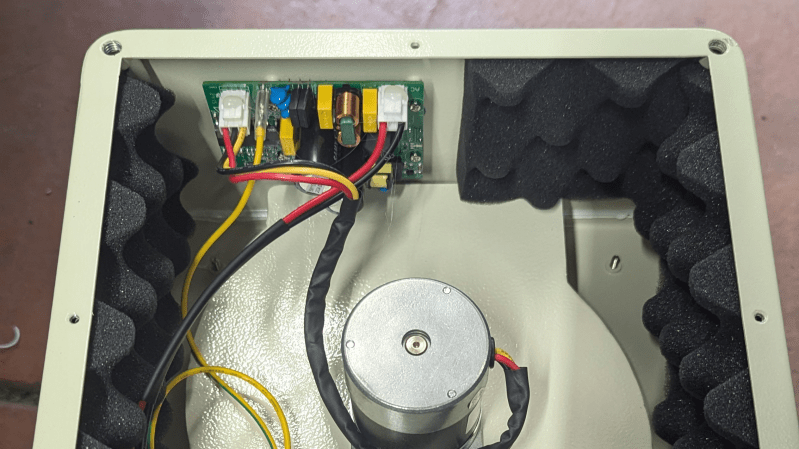[Ryan] purchased a large fume extractor designed to sit on the floor below the work area and pull solder fumes down into its filtering elements. The only drawback to this new filter was that its controls were located near his feet. Rather than kicking at his new equipment, he devised a way to automate it.
By adding a Wemos D1 Mini microcontroller running ESPHome, a relay board, and a small AC-to-DC transformer, [Ryan] can now control the single push button used to cycle through speed settings wirelessly. Including the small transformer inside was a clever touch, as it allows the unit to require only a single power cable while keeping all the newfound smarts hidden inside.
The relay controls the button in parallel, so the physical button still works. Now that the extractor is integrated with Home Assistant, he can automate it. The fan can be controlled via his phone, but even better, he automated it to turn on by monitoring the power draw on the smart outlet his soldering iron is plugged into. When he turns on his iron, the fume extractor automatically kicks in.
Check out some other great automations we’ve featured that take over mundane tasks.















Why is there hot-snot on the power connector and the connector to the motor? Don’t these kind of connectors already have some form of locking of themselves?
Yes, they are latching connectors. Maybe they don’t latch very well. I’m sure you could come up with a reasonable explanation by yourself without having to ask the whole world.
It’s a conspiracy by “Big Hot Glue”.
Yeah they latch, and yeah they’re a bit crap. It’s pretty easy during assembly to bump them and they come loose (and arc), or even vibrate out in shipping. Happens more than you think.
It’s a very very common technique that doesn’t cost much. If you’re going to glue down caps & coils you might as well hit the connectors as well. Occasionally you see silicone used.
You note there’s no hot snot on the spade connector. That’s because as it’s an earth lead it’ll be a latching version, and they’re essentially impossible to remove (even with brute force & swearing), even more-so here where you can’t get at the locking tab easily.
(I did wonder why it was used, using a 4 pin connector there would be better than using 2 x 3 connectors which you might mix up. Was thinking BOM considerations before noticing the green side of the yellow wire.)
That’s a nice hack although I find it a bit overengineered.
There is a simpler version by [OneGeekGuy] that uses a 433 MHz relay circuit from AliExpress. I did this modification based on his idea and could not be happier.
I put the PCB of the receiver in some heatshrink tube and hot glued it to a safe place providing protection against contact with the main PCB or AC connectors.
In addition I superglued 3 small magnets to the red transmitter button for safe storage on the housing of the fan. When soldering I can put it anywhere on my bench and it works like a charm. I wouldn’t want to have the fan running all the time my soldering station is switched on.
TBH in this case simpler is better for me.
Video form [OneGeekGuy]:
https://youtu.be/X-VETthZ3bw?si=bH1Rizp1UuioJTH7
433 MHz transmitter / receiver combo on AliExpress:
https://aliexpress.com/item/1005001802028948.html
Does anyone know the filter type used in this extractor. I’m in need of one but can’t find replacement filters… They claim 10000h live span of the filter but I think this is kind of optimistic.
Have a look at the plate with the serial number next to the power plug. I guess it would be a XF250? Then have a look at AliExpress for “xf250 filter” and voilà you’ll find some that look convincing:
https://aliexpress.com/item/1005006768977058.html
I would want the fume extractor running whenever the soldering iron is on. I currently use a small timer to turn the soldering iron on and more importantly, automatically turn it off if I forget. Why not just power the fume extractor and soldering iron via the same timer? $10.
https://www.amazon.com/Century-Digital-Countdown-Repeat-Function/dp/B01D3QEK4E
I wouldn’t want to see the inside of that box in a few years, all that crumbling foam which seems to go faster in electrical spaces. Some organs loved to use that stuff allover to silence buzzing from bass coating cables with sticky tape versions creating a hell of a de-con mess. If found early it just crumbles off into a vacuum nozzle with a stiff brush, later it’s the goo from hell.